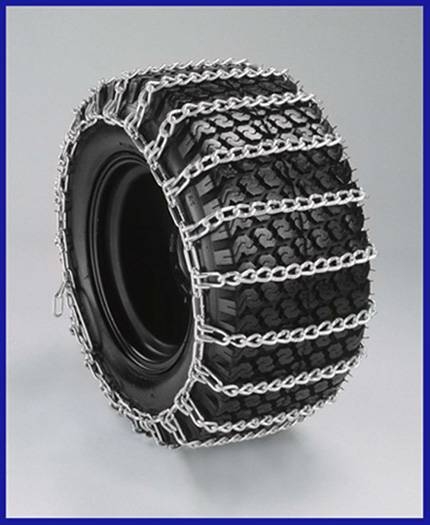
Tractor tire chains are a set of interlocking chains designed to wrap around the tires of a tractor. They are meant to improve the traction that a tire gets in snowy and icy conditions. Given the nature of a tractor's work, should a tractor become bogged down in snow or ice, there's little chance of getting it out until the spring thaw. For that reason, putting chains on its tires can save you a lot of stress ahead of time. Tire chains aren't foolproof, though. They can slip if the tractor drives too fast. They can break if the tractor drives across pavement or asphalt. A better choice is using tractor tires specially designed for snowy conditions. However, this is very costly.
Small tires, such as those used by a garden tractor, are most easily wrapped in tire chains if they are first removed from the axle of the tractor. Lay the chains on the ground, making sure that the cross chains aren't twisted and the side chains are pulled out as far as possible. The tire should be placed upright at the center of the chains. The two sides of the chain assembly should differ. The inner-side chain will have a simple eye and hook at either end. This is the side that will face inward toward the tractor's axle. The other side of the chains will have a simple chain link on one end and a fold-over locking plate on the other. Drape both ends of the chain over the tire. Connect the eye and hook, keeping the chain taut the entire time. The fold-over locking plate is designed to take up any slack in the chains. Just connect it to the furthest chain link on the tire that can be reached, and then cinch it tight. With this done, the tire can be put back on the tractor and the other tire treated in the same fashion.
Large tires, such as on farming tractors, are far too big and heavy to safely remove to install tire chains. For that reason, you lay out the tire chains side by side on the ground and drive the tractor over them, keeping the tires in the center of each chain assembly. They connect the same way that small tires do, using a fold-over locking plate to take up the slack. Large tires tend to put more pressure on their chains, though, causing them to shift and sometimes come off as a result. For that reason, a tensioner is used. It's a single metal ring at the center, with six lengths of chain radiating outward. Near the ring on each chain is a device that, when turned with a wrench, will expand or contract. The chains are attached to the exterior chain of the tire, so the metal ring hangs taut over the center of the wheel and the chains form a hexagonal pattern. The tension-altering devices are tightened as much as possible. This ensures the chain does not pull away from the tire as the tractor is used.